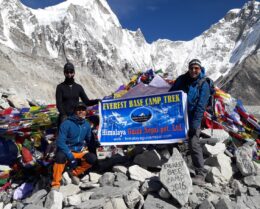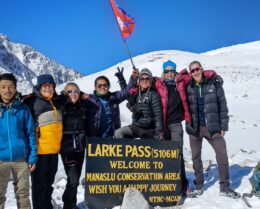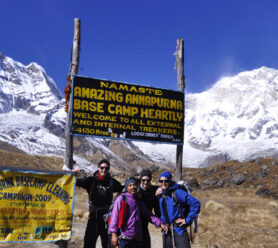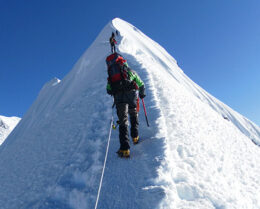Best Trekking in Nepal in 2024
UPDATED ON 6 March, 2024
Those who are captivated by the shape and heights of towering mountains may find that the Himalayas, or Himalayas, or Himal is one of the most extensively studied phrases in history. This is a broad overview for anyone who would rather trek in Nepal. In Nepal, the Himalayas, which are covered in white snow, envelop you and can be seen from three distinct locations: the Plain Tarai, the Hills, and the Himalayas. Today in this article we will talk about the best Trekking in Nepal in 2024.
The finest place to see the Himalayas is even while traveling across Nepal’s slopes. This can be a multi-day excursion into lower altitudes or a day hike.
The Himalayas are mostly found in Nepal, Tibet, India, Pakistan, Bhutan, and Afghanistan; their names vary according to regional religion and culture. Nepal is the tallest country in the world and has the record for having the most numbers among them.
With an elevation of 8,848.86 meters, Mount Everest is one of the world’s highest mountains and Nepal is home to 8 of the top 14 mountains.
The Asian Himalayas are sacred mountains, primarily associated with mythology. The snow-covered mountain is more holy and religious since it is the home of gods and goddesses. However, a great number of artistic beings have journeyed deep into the Himalayas for the sake of penance and meditation.
This holds true for South Asia’s two most common and prominent religions, Buddhism and Hinduism. The high Himalayas are home to several Buddhist monasteries and temples, and one can sense the intense spiritual atmosphere there. In order to be freed from the realm of material things, devotees travel to those temples and monasteries.
About the Himalayas of Nepal
The Himalayas are a lengthy range of lofty mountains that were created by subterranean movement between 50 and 60 million years ago. It was a movement created when several tectonic plates met beneath one another, raising a solid rock hump upward.
Furthermore, the Himalayas were formed millions of years ago by the raising of massive compacted materials from the earth due to the similar densities of the Eurasian and Indian plates beneath.
Over an extended duration, this process gives rise to the Himalayas, with Mount Everest standing at the highest point on Earth (8,848.86 meters).
The Himalayas are fascinating because they are constantly rising and many other mountain peaks are changing in size and shape.
For the first time in its history, Mt. Everest’s height was measured during an Indian survey in 1954, and the official measurement was 8,848 meters. Mount Everest continues to rise as a result of the tectonic plate movements beneath it, having gained over a meter in height during the past 67 years.
In 2020, the governments of China and Nepal collaborated to measure the summit of Mount Everest, which resulted in a legitimate statement of 8,848.86 meters.
How high are Nepal’s Himalayas?
From the Kali River in the east to the Tista River in the west, the Nepalese Himalayas span almost 800 kilometers. Nepal has 26% of its territory included by means of the Himalayas, which might be the least populated in the globe. The Himalayas get their call from their height and variety.
The Himalayas are generally above 3,300 meters in Nepal, with 8,848.86 meters being the highest height. With an elevation of 8,848.86 meters, Mount Everest is the best mountain in the international, and Nepal is home to eight of the world’s 14 highest mountains.
Because of the tectonic plate beneath the earth, the height of the Himalayas is continuously shifting. As the Eurasian and Indian plates collide greater forcefully underneath each other, new mountains are created and those that already exist continue to rise.
What are the Popular Trekking Destinations in Nepal?
A trek over Nepal’s Himalayas is always an adventure. This will transport you to one of the most alluring locations away from the world of materialism.
Similarly, numerous trekking routes may be found in Nepal’s Himalayas, mostly divided into three well-liked categories: Peak Climbing Trek, High Himalayan Trek, and Low Himalayan Trek.
Your journey to reach the summit will mostly follow the trail down to an elevation of less than 7,000 meters. This will involve a hike in addition to a climb up one of the well-known Himalayan peaks, including Island Peak, Mera Peak, Lobuche Peak, etc.
As you climb through the high passes, into the Base Camp of the high mountains, and descend past the Himalayan lakes, the High Himalayan Trek will bestow upon you a breathtaking panorama of the Himalayas.
This comprises treks to Everest Base Camp, Three Pass, Annapurna Base Camp, Ama Dablam, Dhaulagiri, Round Annapurna, and so on.
Other than this, there are dozens of options for a quick hike through Nepal’s Himalayas. In comparison to the Peak Climbing Trek and the High Himalayan Trek, these are lower in altitude.
Treks within the decreased Himalayas encompass the Ghorepani Trek, the Upper Mustang Trek, the Mardi Himal Base Camp Trek, the Pikey Peak Trek, and Namche Bazaar Trek.
What is best while trekking in Nepal?
The Himalayas of Nepal cover around 26% of land place. The number one divisions of this terrain are the High Himalayas and the Low-land Himalayas.
Discovering the various flowers and taking inside the breathtaking angle of the surrounding Himalayas is one of the maximum fascinating viewpoints.
Moreover, the stroll will offer you lots of versions in the lower altitudes in terms of the numerous groups’ hospitality, customs, cultures, and religions, similar to extraordinary plants and fauna.
Furthermore, simplest the Sherpa network can be inhabited while you go higher in the Himalayas. Smaller and more dispersed are the villages. It could be an isolated journey through the wilderness, whole with breathtaking vistas from an increased vantage factor and Himalayan fauna, inclusive of alpine birds.
What is the best time to trek in Nepal?

It is possible to trek into the upper Himalayas year-round. The reason for this is that the weather is still significantly better than it is in the lower places. Even during the monsoon season, when the lower region receives the most rainfall, there is little chance of rain.
Despite all of this, spring and fall are the best seasons for trekking in the high Himalayas. February, March, April, May, August, September, October, and November are included in this.
The weather is at its finest this time of year. with a beautiful, unobstructed view of the azure sky. There are no monsoon clouds in the area to obstruct the trail at lower altitudes.
Rainfall rarely occurs at high altitudes, but the majority of your walk begins at a lower elevation. In June and July, during the Monsoon season, the lower altitude paths are not well maintained.
Rainfall will occur, perhaps affecting your trek and occasionally preventing you from getting to your destination by plane.
Additionally, the trails will be fantastic at lower elevations throughout the winter (December and January), but at higher elevations, there will be heavy snowfall and a chance of avalanches, which could leave you stranded in a certain camp for a few days.
It is therefore advised that anyone planning a high altitude climb over 4200 meters opt for the spring or autumn seasons.
How hard is it to trek in Nepal
Trekking in Nepal’s Himalayas is a difficult undertaking; a moderate hike will lead to a demanding climb. This holds for all of Asia’s extensive Himalayan region. Two distinct viewpoints are primarily used to construct this idea.
First, the trail: There is always a low starting point for trekking in the Himalayas, and the trail is kept in good condition. This is because residents regularly keep those paths in good condition for their own use.
Now, as you go higher, the area becomes more constrained and has fewer inhabited residents. Because of this, the trails won’t be maintained much in December and January.
Second, the best way to overcome any altitude issue is to start at a lower altitude and keep a normal pace. The amount of oxygen decreases as you hike higher, therefore if your body is not properly acclimated, you may get symptoms associated with altitude.
Most Famous trekking journey in Nepal
Everest Base Camp Trek

One of the most famous walks in the world is the journey to Everest Base Camp. This needs to be at the top of your list if you enjoy walking! Our lodge-based journey meticulously replicates Edmund Hillary’s route, giving you enough time to properly acclimate and take in the surroundings.
After taking an exhilarating flight into Lukla, the journey continues through the breathtaking Khumbu Valley to reach Everest Base Camp. After a quick ascent to the summit of Kala Pattar, which offers breathtaking views of the world’s highest peak, we return to Lukla by following our original route.
Annapurna Base Camp Trek
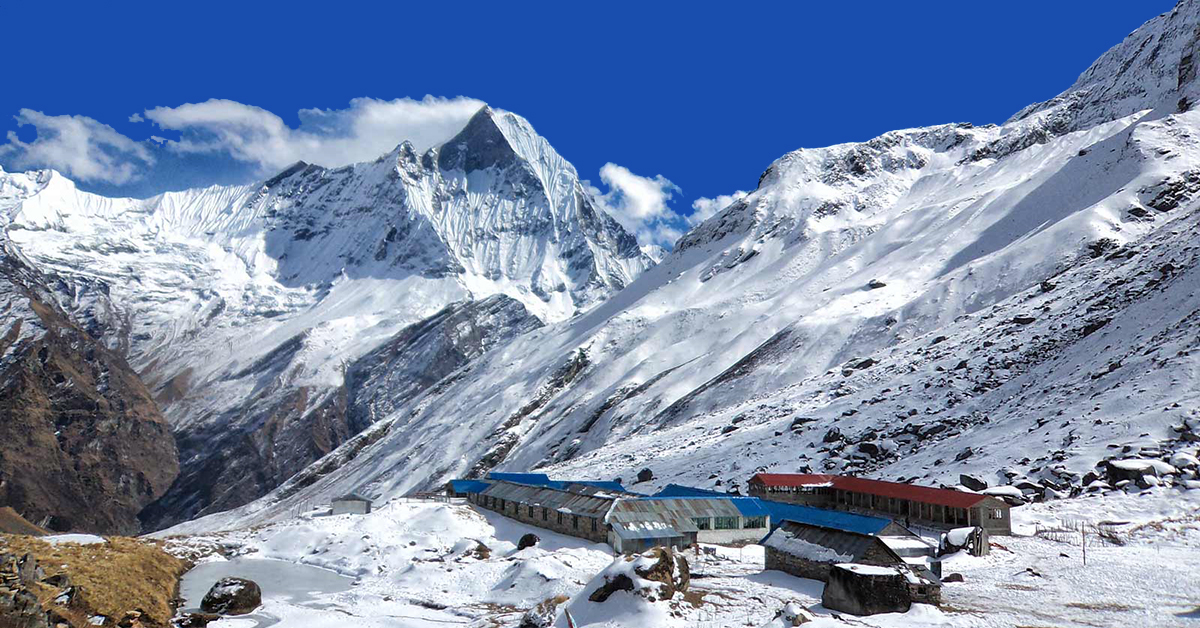
The Annapurna Base Camp trek, with its blend of natural and cultural features, draws some 70,000 hikers each year, making it perhaps the most magnificent trekking trail in the world. At 4,130 meters (13,549 feet) above sea level, the Annapurna Base Camp Trek’s objective, the base camp of Mt. Annapurna I, offers us a wealth of natural scenery as well as the rare opportunity to learn about the vibrant cultures of the ethnic Gurung and Magar villages.
This hike offers you a tour of a living cultural museum and breathtaking views of the Himalayas. Rice terraces, subtropical forests, and charming villages are all visible along the route.
The ABC trip incorporates several well-known Himalayan summits, including Dolpo, Dhaulagiri, Machhaapuchhre, Gangapurna, and Annapurna I and III, as it gradually ascends the peak.
The sunrise in the camp is another highlight of the journey. There’s nothing like waking up to the magnificent spectacle of the sun painting the peaks of the Himalayas. It is understandable why hikers who visit the Annapurna region repeatedly return to explore its amazing paths.
Ghorepani Poonhill Trekking

The Ghorepani Poon Hill Trek is a great preparation for the stunning trekking in the Annapurna region. The breathtaking mountain scenery, charming hills blanketed in rhododendron plants, clean mountain air, and hospitable, friendly communities are well-known for their rage.
For hikers of all ages, the Annapurna Conservation Area provides a short, easy hike. Trekkers shouldn’t be concerned about acute mountain sickness because they will be at 3,210 meters, the highest point possible.
One of the most well-liked and frequently visited vistas in Nepal is Poon Hill. Perched at an elevation of 3,210 meters above sea level, it offers stunning views of the Mardi Himal, Mt. Dhaulagiri, Mt. Annapurna, Ghorepani Village, and numerous other mountains. Poon Hill, a short climb from Pokhara, is the family and friend group’s favorite spot for sunrise views.
Annapurna Circuit Trek

The Annapurna Circuit used to be a three-week trek through the unspoiled valleys and towns of the Annapurna range, but it has been drastically reduced by the building of two roads that are intruding on both sides.
It may take as few as five days to finish the roadless portion of the Annapurna Circuit once the last road is built, the date of which is uncertain and always postponed. But now it is best Trekking in Nepal in 2024.
Manaslu Trek

Nepal’s northern Himalayan region, the Manaslu Region, offers some of the most breathtaking trekking experiences the nation has to offer. The Sanskrit word “Manasa,” which means “Intellect” or “Soul,” is the source of the word “Manaslu.” With a height of 8,163 meters, Manaslu is the eighth-highest peak in the world.
During your 12-day trek in the Manaslu Conservation Area, you will be able to witness the breathtaking view of Manaslu. Buddha Himal, Himal Chuli Peak, Ganesh Himal in the east, and Annapurna Himalaya in the west are some of the other peaks that you can see.
Situated in the west-central section of the Nepalese Himalayas, the Manaslu region is among the most easily accessible trekking destinations from Kathmandu. After an 8 to 10-hour trip from Kathmandu on a combination of paved and mud roads, you can arrive at the starting and finishing points of the hike.
You will travel across the Nepali countryside on this difficult yet breathtaking road trip, going past little towns, terraced crops, flowing rivers, lush hills, and distant snow-capped mountains.
Conclusion
Some of the tallest mountains in the world, including Mount Everest, Annapurna, and Kanchenjunga, are found in Nepal. The Himalayas draw adventure seekers from all over the world with their stunning landscapes and strenuous trekking routes.
Some Similar posts

